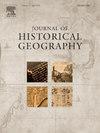The Yellowstone as the longest undammed river in the contiguous United States: An environmental historical geography of a mythic landscape
IF 1.3
2区 历史学
Q2 GEOGRAPHY
引用次数: 0
Abstract
This article contributes to a body of scholarship examining the relationship between myth and geography. Specifically, I integrate a posthumanist understanding of assemblage theory to better account for the role that more-than-human entities play in the creation and transformation of mythic landscapes. To support this line of inquiry, I adopt Bowden's geographical traditions model to help trace the origin and evolution of a particular myth – the Yellowstone River as the longest undammed or free-flowing river remaining in the contiguous United States – from its beginnings in the wild and scenic rivers movement of the late 1950s and early 1960s to contemporary environmental conflicts that expose its contradictions and threaten its continued existence. I argue that actors within the Montana Department of Fish and Game – embedded within an active and dynamic environment – created a new myth for the Yellowstone River throughout the late 1970s as a political tool to gain legal protection for the river. During the 1980s and 1990s, however, I argue that this myth transformed and took on the aura of an inviolate landscape. Consequently, I argue that the myth's relationship to environmental protection became more ambiguous than its creators had originally intended.
黄石公园是美国毗连地区最长的无水坝河流:神话景观的环境历史地理学
本文对研究神话与地理之间关系的学术研究有所贡献。具体而言,我结合了后人文主义对集合理论的理解,以更好地解释非人类实体在神话景观的创造和转变中所扮演的角色。为了支持这一研究思路,我采用了鲍登的地理传统模型,以帮助追溯一个特定神话的起源和演变过程--黄石河是美国毗连地区最长的无水坝或自由流淌的河流--从 20 世纪 50 年代末和 60 年代初的 "野生和风景优美的河流 "运动开始,到暴露其矛盾并威胁其继续存在的当代环境冲突。我认为,蒙大拿州鱼类和狩猎部的参与者们在活跃多变的环境中,在整个 20 世纪 70 年代末为黄石河创造了一个新的神话,作为一种政治工具,为河流争取法律保护。然而,在 20 世纪 80 年代和 90 年代,我认为这一神话发生了转变,披上了不可侵犯的景观的外衣。因此,我认为该神话与环境保护之间的关系变得比其创造者的初衷更加模糊。
本文章由计算机程序翻译,如有差异,请以英文原文为准。
求助全文
约1分钟内获得全文
求助全文
来源期刊

Journal of Historical Geography
Multiple-
CiteScore
1.50
自引率
10.00%
发文量
53
期刊介绍:
A well-established international quarterly, the Journal of Historical Geography publishes articles on all aspects of historical geography and cognate fields, including environmental history. As well as publishing original research papers of interest to a wide international and interdisciplinary readership, the journal encourages lively discussion of methodological and conceptual issues and debates over new challenges facing researchers in the field. Each issue includes a substantial book review section.
 求助内容:
求助内容: 应助结果提醒方式:
应助结果提醒方式:


